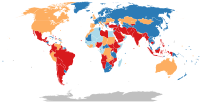
Photo from wikipedia
Operating schools safely during the COVID-19 pandemic requires a balance between health risks and the need for in-person learning. Using demographic and epidemiological data between 31 July and 23 November… Click to show full abstract
Operating schools safely during the COVID-19 pandemic requires a balance between health risks and the need for in-person learning. Using demographic and epidemiological data between 31 July and 23 November 2020 from Toronto, Canada, we developed a compartmental transmission model with age, household and setting structure to study the impact of schools reopening in September 2020. The model simulates transmission in the home, community and schools, accounting for differences in infectiousness between adults and children, and accounting for work-from-home and virtual learning. While we found a slight increase in infections among adults (2.2%) and children (4.5%) within the first eight weeks of school reopening, transmission in schools was not the key driver of the virus resurgence in autumn 2020. Rather, it was community spread that determined the outbreak trajectory, primarily due to increases in contact rates among adults in the community after school reopening. Analyses of cross-infection among households, communities and schools revealed that home transmission is crucial for epidemic progression and safely operating schools, while the degree of in-person attendance has a larger impact than other control measures in schools. This study suggests that safe school reopening requires the strict maintenance of public health measures in the community.
Journal Title: Royal Society Open Science
Year Published: 2022
Link to full text (if available)
Share on Social Media: Sign Up to like & get
recommendations!